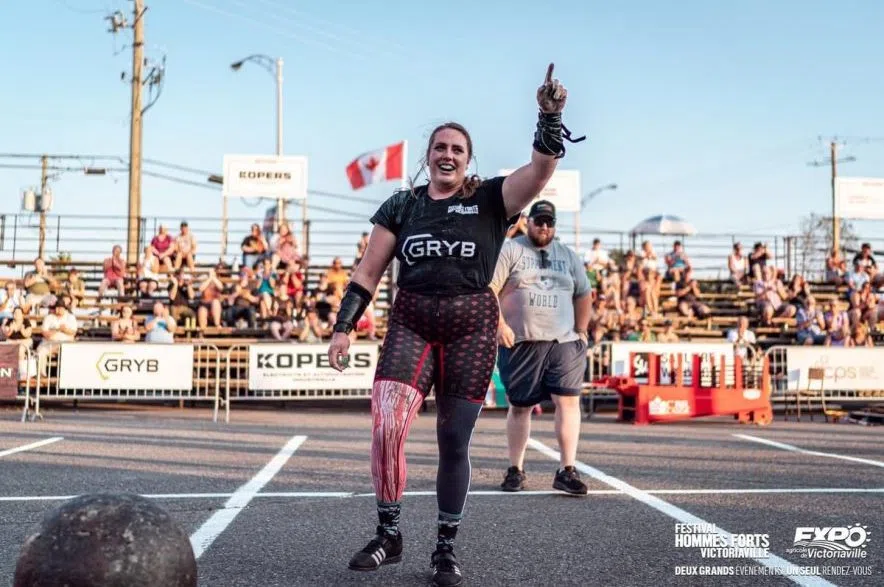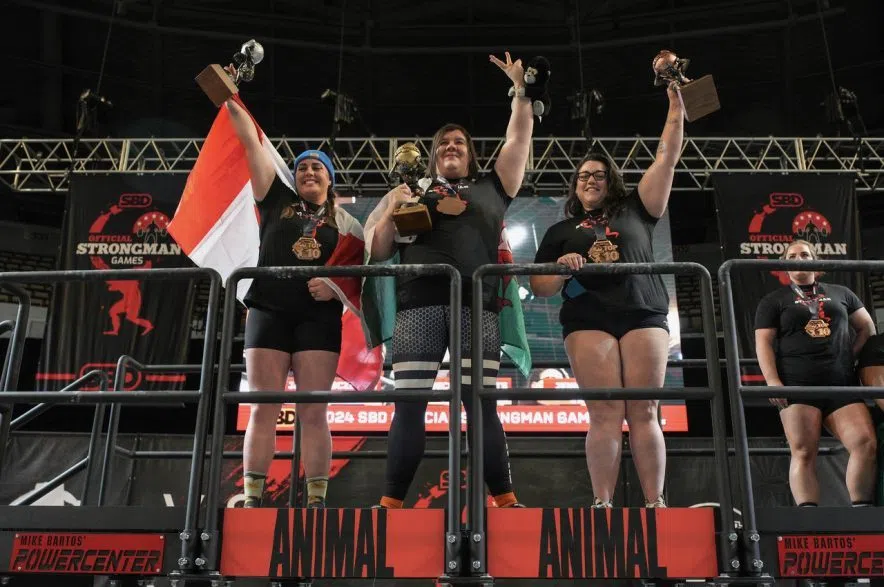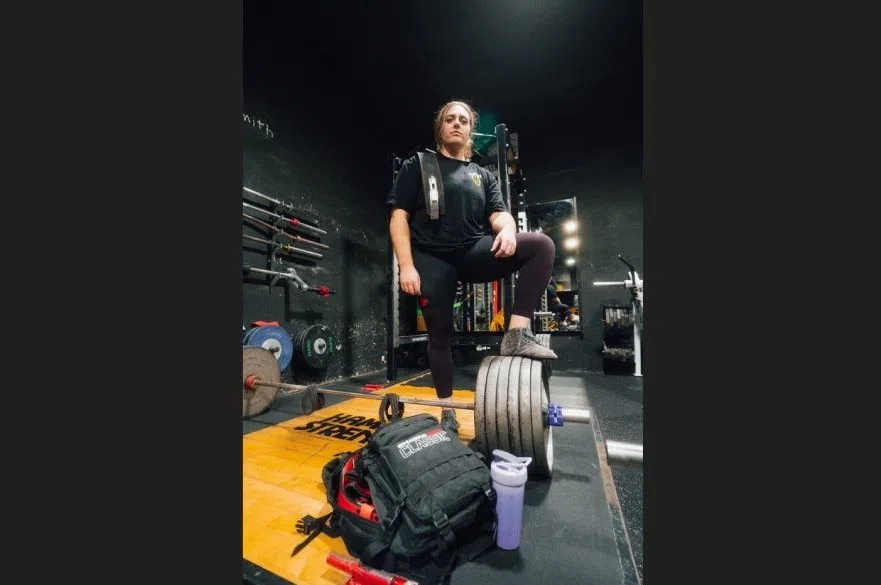When Jackie Osczevski walks onto the competition floor, there’s no glitter, no spotlight choreography and no scorecards.
Just steel, stone, rubber, gravity and the quiet confidence of a woman who knows exactly how strong she is.
Over the past decade, that strength has earned Osczevski a place among the elite. She’s been named Western Canada’s Strongest Woman three times, she’s stood on the podium three times at nationals, and has also claimed the title of the second strongest woman in the world.
“It’s just a bunch of odd object lifting. Anything from truck pulls with the harness on you, or sitting down and pulling a truck towards you, stone lifting, log pressing,” she explained. “It’s super fun. In some competitions you flip cars, which I have yet to do. I’d love to flip a car!”
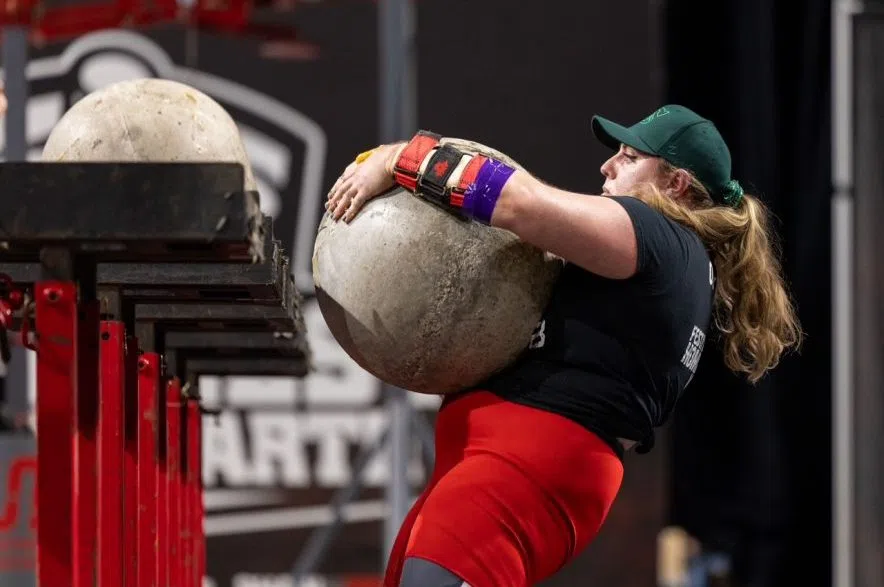
Strongwoman competitions involve lifting and moving “odd objects” like stones, logs, tires or even cars. (Submitted)
This is the world of strongwoman, a rapidly growing sport in which women haul, heave, drag and deadlift incredibly heavy objects.
Read more Saskatchewan Stories from Brittany Caffet:
- Behind the spandex: The real-life drama of Prairie Pro Wrestling
- ‘Wow, this is hard’: The joyful struggle of learning the bagpipes
- Saskatoon’s Harley Lorenz grapples with vision loss – and wins
Osczevski, a Saskatoon-based kinesiologist, is fierce competitor and one of the sport’s most passionate advocates.
“It’s a different way of health and fitness that I don’t think the general population would ever consider,” she said. “There (are) so many big farm girls in Saskatchewan. We’re not small — we have broad shoulders, we have broad hips. I am not skinny. I’ll never get skinny. There’s a fitness out there that is built for us.”
Listen to Brittany Caffet talk to Jackie Osczevski about her journey to becoming a strongwoman:
The beauty of unconventional strength
At first glance, strongwoman can seem extreme: women hoisting 200-pound stones onto platforms, running while carrying anvils and pulling vehicles by hand. But beneath the spectacle lies a sport built on raw, measurable power.
“It’s a true competition. May the fastest one win, may the strongest one win,” Osczevski said.
“Versus technical things, like figure skating or bodybuilding… Judges can be biased. But the time doesn’t lie. The stopwatch doesn’t lie. Being stronger doesn’t lie.”
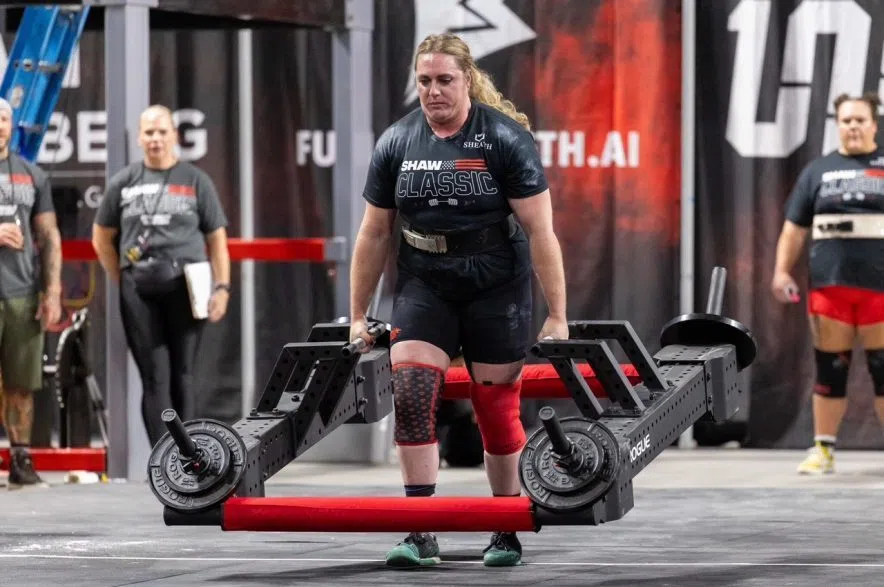
Strongwoman events are judged by performance, not aesthetics. There are no style points — just time, distance, and weight. (Submitted)
Strongwoman is refreshingly objective. You either lift the weight or you don’t. You cross the finish line or you don’t. There’s no panel to impress — just grit, muscle and iron will.
But as the sport gains traction across Canada, Osczevski said Saskatchewan still lags behind other provinces.
“Alberta is booming. Manitoba is booming. Ontario’s huge. Saskatchewan, because of how spread out we are, it is slowly growing, but the other provinces are absolutely blasting off.”
She’s hopeful that stories like hers will help the sport find a foothold in her home province.
More than muscle
Osczevski is not only an athlete. She’s a trained kinesiologist who approaches the sport with an appreciation for the science behind strength.
Her warm-ups and mental prep aren’t about hype or theatrics — they’re neurologically tuned.
“For me, I really like science-based stuff,” she said.
“I’ll actually slap my thighs, because that’s a central nervous system response… it’ll shoot a boost of adrenaline. I like to be smart with how I psych myself up.”
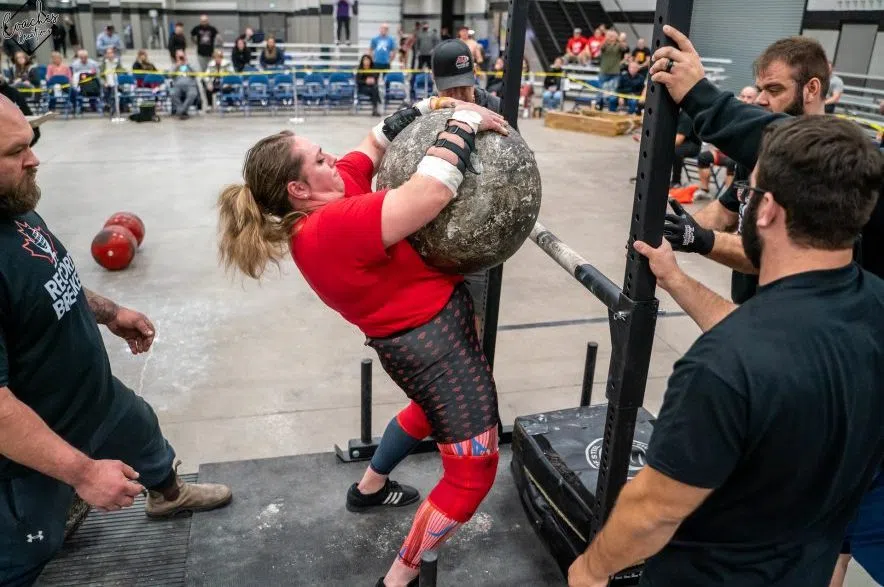
Strongwoman is one of the most inclusive strength sports. Women of all sizes and backgrounds compete, proving that strength isn’t one-size-fits-all. (Submitted)
Osczevski said her scientific approach also helps her navigate the psychological toll of high-level competition.
“There were massive mental blocks that I was facing,” she shared. “My sports psychologist taught me to zone out, go to a happy place, and then give yourself about 10 or 20 seconds in that zone, and then turn it on and just get aggressive. Whatever that looks like to you.”
Sisterhood in steel
Despite being an individual sport, strongwoman fosters a rare kind of camaraderie.
Osczevski beams when talking about the women she competes with.
“I’ve made a lot of good relationships. These girls are my sisters, essentially, so I want to see them do well,” she said. “And when they do, I definitely celebrate. I don’t hold back, even if I lose.”
Although the sport is often mistaken as brutish or solitary, strongwoman has built something profoundly beautiful: a place where women lift each other up — sometimes literally — and push one another to be their best.
“I do cheer for my friends, because I want to beat their best version,” Osczevski said. “I don’t want to beat their worst version.”
Still, make no mistake, Osczevski is a fierce competitor.
“I grew up with brothers, so I’m still competitive!” she laughed.
Redefining femininity
Osczevski said she’s proud to be part of a sport that challenges long-held ideas about what women should look like and what they are capable of.
“The biggest (stereotype) being women who lift heavy look like men,” she scoffed. “The person saying I look like a man looks like the softest jelly belly I’ve ever seen who sits on his couch all day.”
At one point, she said those comments stung.
“It really bothered me,” she admitted. “I’m very feminine. If you get to know these girls, you’ll actually see how beautiful they are. It’s just a shock to people when they see a woman with big traps and big shoulders and big legs, but it doesn’t change a personality. People are beautiful from within.”
Osczevski’s sport doesn’t ask her to shrink herself or fit into anyone else’s idea of femininity. It invites her to be powerful, take up space and celebrate her body for what it can do, not just how it looks.
“When are you going to see a woman walk a 320-pound anvil for 150 feet?” she asked, laughing. “It’s mind-boggling. To see women succeed in strength, I feel like that’s a big mental win for women.”
The weight of progress
Of course, like any athlete, Osczevski’s life isn’t all podiums and PRs. The work to get there is grueling.
“It is exhausting. I am sore, I am tired, I’m hungry,” she said. “I’m taking it to the next level. If you were to just do this for fun, you would have the endorphin rush, but I’m pushing beyond that.”
Through the grit and the grind, Osczevski said it’s the milestones that keep her going.
“The accomplishment that comes with hitting something that I’ve been chasing for a week, a month, two months… it’s awesome. To see that progression, to see that personal growth, it’s very validating.”
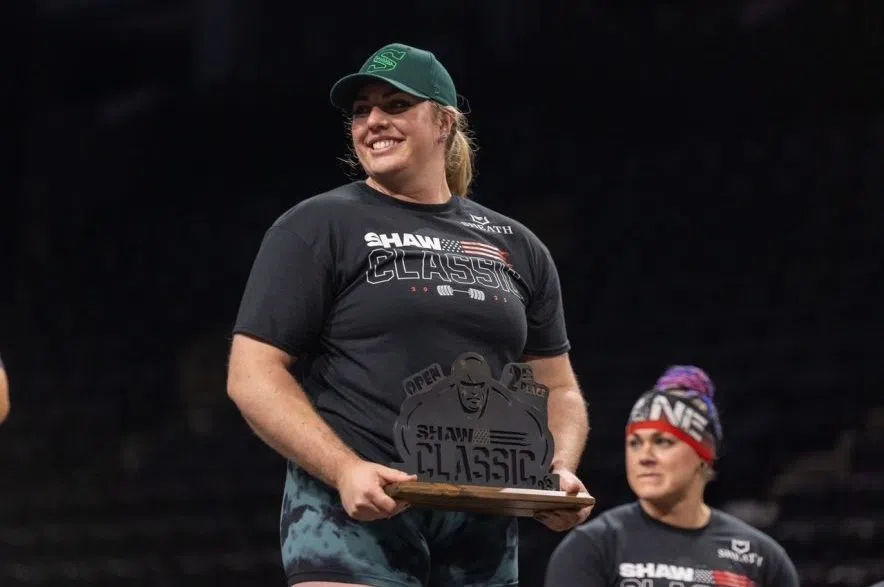
Saskatchewan may not have a booming strongwoman scene yet, but Osczevski is helping build it. One podium at a time, she’s growing awareness across the Prairies. (Submitted)
To women who look at her feats and think, “I could never,” Osczevski offered a gentle reminder.
“Not a lot of women think about it. They’re like, ‘Oh, I can’t do what you do.’ Yeah, well, I couldn’t do what I’m doing now nine years ago. It took time.”
Time, and a stubborn refusal to let anyone else define what a strong woman should look like.
In Jackie Osczevski’s world, strength isn’t a spectacle; it’s a celebration of women stepping fully into their power.
